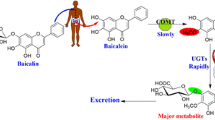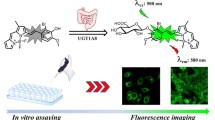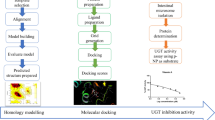Abstract
Background
d-luciferin is one of the most commonly used substrates in bioluminescence imaging for real-time monitoring of sophisticated biological processes in models of human biology or disease in vitro and in vivo. d-luciferin is rapidly cleared from blood circulation after being exogenously delivered in vivo and the presence of phenolic groups indicates that glucuronide conjugation is a possible metabolic pathway for the compound.
Objectives
This study aimed to characterize the glucuronidation pathway of d-luciferin in human liver microsomes (HLM) and human intestine microsomes (HIM).
Methods
HLM and HIM were employed to catalyze the glucuronidation of d-luciferin in vitro. The activity of recombinant uridine-diphospho-glucuronosyltransferase (UGT) isoforms towards d-luciferin glucuronidation was screened. Chemical inhibition assay and kinetic analysis was combined to determine the UGT isoforms responsible for the formation of d-luciferin glucuronide in HLM and HIM.
Results
d-luciferin could be catalyzed to form one mono-glucuronide which was characterized as 6′-O-glucuronide in HLM and HIM. UGT1A1, 1A3, 1A6, 1A8, 1A9 and 1A10 participated in the formation of d-luciferin glucuronide, with UGT1A1 exhibiting the highest catalytic activity. Both chemical inhibition assays and kinetic analysis showed that UGT1A1 and UGT1A3 played important roles in d-luciferin-6′-O-glucuronidation in HLM and HIM, with UGT1A6 also giving a non-negligible contribution to this biotransformation in HLM.
Conclusions
UGT1A1, UGT1A3 and UGT1A6 were responsible for 6′-O-glucuronidation of d-luciferin in HLM, while UGT1A1 and UGT1A3 were the major contributors to this biotransformation in HIM.






Similar content being viewed by others
References
Edinger M, Sweeney TJ, Tucker AA, Olomu AB, Negrin RS, Contag CH. Noninvasive assessment of tumor cell proliferation in animal models. Neoplasia. 1999;1(4):303–10.
Sweeney TJ, Mailänder V, Tucker AA, Olomu AB, Zhang W, Cao Ya, Negrin RS, Contag CH. Visualizing the kinetics of tumor-cell clearance in living animals. Proc Natl Acad Sci USA. 1999;96(21):12044–9.
Tang Y, Shah K, Messerli SM, Snyder E, Breakefield X, Weissleder R. In vivo tracking of neural progenitor cell migration to glioblastomas. Hum Gene Ther. 2003;14(13):1247–54.
Zhang W, Feng JQ, Harris SE, Contag PR, Stevenson DK, Contag CH. Rapid in vivo functional analysis of transgenes in mice using whole body imaging of luciferase expression. Transgenic Res. 2001;10(5):423–34.
Contag CH, Bachmann MH. Advances in in vivo bioluminescence imaging of gene expression. Annu Rev Biomed Eng. 2002;4:235–60.
Berger F, Paulmurugan R, Gambhir SS. Uptake kinetics and biodistribution of 14C d-luciferin, a radiolabeled substrate for the firefly luciferase catalyzed bioluminescent reaction. J Nucl Med. 2003;44:317.
Berger F, Paulmurugan R, Bhaumik S, Gambhir SS. Uptake kinetics and biodistribution of 14C-d-luciferin–a radiolabeled substrate for the firefly luciferase catalyzed bioluminescence reaction: impact on bioluminescence based reporter gene imaging. Eur J Nucl Med Mol Imaging. 2008;35(12):2275–85.
Fujita K, Sugiyama M, Akiyama Y, Ando Y, Sasaki Y. The small-molecule tyrosine kinase inhibitor nilotinib is a potent noncompetitive inhibitor of the SN-38 glucuronidation by human UGT1A1. Cancer Chemother Pharmacol. 2011;67(1):237–41.
Huang YP, Cao YF, Fang ZZ, Zhang YY, Hu CM, Sun XY, Yu ZW, Zhu X, Hong M, Yang L, Sun HZ. Glycyrrhetinic acid exhibits strong inhibitory effects towards UDP-glucuronosyltransferase (UGT) 1A3 and 2B7. Phytother Res. 2013;27(9):1358–61.
Zhang YS, Tu YY, Gao XC, Yuan J, Li G, Wang L, Deng JP, Wang Q, Ma RM. Strong inhibition of celastrol towards UDP-glucuronosyl transferase (UGT) 1A6 and 2B7 indicating potential risk of UGT-based herb-drug interaction. Molecules. 2012;17(6):6832–9.
Zhu L, Ge G, Liu Y, He G, Liang S, Fang Z, Dong P, Cao Y, Yang L. Potent and selective inhibition of magnolol on catalytic activities of UGT1A7 and 1A9. Xenobiotica. 2012;42(10):1001–8.
Uhrbom L, Nerio E, Holland EC. Dissecting tumor maintenance requirements using bioluminescence imaging of cell proliferation in a mouse glioma model. Nat Med. 2004;10:1257–60.
Lyons SK, Meuwissen R, Krimpenfort P, Berns A. The generation of a conditional reporter that enables bioluminescence imaging of Cre/loxP-dependent tumorigenesis in mice. Cancer Res. 2003;63:7042–6.
Ciana P, Raviscioni M, Mussi P, Vegeto E, Que I, Parker GM, Lowik C, Maggi A. In vivo imaging of transcriptionally active estrogen receptors. Nat Med. 2003;9:82–6.
Carlsen H, Moskaug JO, Fromm SH, Blomhoff R. In vivo imaging of NF-kappa B activity. J Immunol. 2002;168:1441–6.
Rehemtulla A, Stegman LD, Cardozo SJ, Gupta S, Hall ED, Contag HC, Ross DB. Rapid and quantitative assessment of cancer treatment response using in vivo bioluminescence imaging. Neoplasia. 2000;2:491–5.
Wang X, Rosol M, Ge S, Peterson D, McNamara G, Pollack H, Kohn BD, Nelson DM, Crooks MG. Dynamic tracking of human hematopoietic stem cell engraftment using in vivo bioluminescence imaging. Blood. 2003;102:3478–82.
Ohno S, Nakajin S. Determination of mRNA expression of human UDP-Glucuronosyltransferases and application for localization in various human tissues by real-time reverse transcriptase-polymerase chain reaction. Drug Metab Dispos. 2009;37:32–40.
Court MH, Zhang X, Ding X, Yee KK, Hesse ML, Finel M. Quantitative distribution of mRNAs encoding the 19 human UDP-glucuronosytrasferase enzymes in 26 adult and 3 fetal tissues. Xenobiotica. 2012;42(3):266–77.
Fallon KJ, Neubert H, Goosen CT, Smith CP. Targeted precise quantification of 12 human recombinant Uridine-diphosphate glucuronosyltransferase 1A and 2B isoforms using nano-ultra-high-performance liquid chromatography/tandem mass spectrometry with selected reaction monitoring. Drug Metab Dispos. 2013;41:2076–80.
Sato Y, Nagata M, Tetsuka K, Tamura K, Miyashita A, Kawamura A, Usui T. Optimized methods for targeted peptide-based quantification of human uridine-5′-diphosphate-glucuronosyltransferases in biological specimens using liquid chromatography-tandem mass spectrometry. Drug Metab Dispos. 2014;42:885–9.
Higashi E, Ando A, Iwano S, Murayama N, Yamazaki H, Miyamoto Y. Hepatic microsomal UDP-glucuronosyltransferase (UGT) activities in the microminipig. Biopharm Drug Dispos. 2014;35:313–20.
Guo B, Fang ZZ, Yang L, Xiao L, Xia YL, Gonzalez FJ, Zhu LL, Cao YF, Ge GB, Yang L, Sun HZ. Tissue and species differences in the glucuronidation of glabridin with UDP-glucuronosyltransferases. Chem Biol Interact. 2015;231:90–7.
Wen ZM, Martin DE, Bullock P, Lee KH, Smith PC. Glucuronidation of anti-HIV drug candidate bevirimat: identification of human UDP-glucuronosyltransferases and species differences. Drug Metab Dispos. 2007;35:440–8.
Shelby MK, Cherrington NJ, Vansell NR, Klaassen CD. Tissue mRNA expression of the rat UDP-glucuronosyltransferase gene family. Drug Metab Dispos. 2003;31(3):326–33.
Emi Y, Ikushiro S, Iyanagi T. Drug-responsive and tissue-specific alternative expression of multiple first exons in rat UDP-glucuronosyltransferase family 1 (UGT1) gene complex. J Biochem. 1995;117(2):392–9.
Grams B, Harms A, Braun S, Strassburg CP, Manns MP, Obermayer-Straub P. Distribution and inducibility by 3-methylcholanthrene of family 1 UDP-glucuronosyltransferases in the rat gastrointestinal tract. Arch Biochem Biophys. 2000;377(2):255–65.
Buckley DB, Klaassen CD. Tissue- and gender-specific mRNA expression of UDP-glucuronosyltransferases (UGTs) in mice. Drug Metab Dispos. 2007;35(1):121–7.
Dothager SR, Flentie K, Moss B, Pan MH, Kesarwala A, Piwnica-Worms D. Advances in bioluminescence imaging of live animal models. Curr Opin Biotechnol. 2009;20(1):45–53.
Gross S, Abraham U, Prior JL, Herzog ED, Piwnica-Worms D. Continuous delivery of d-luciferin by implanted micro-osmotic pumps enables true real-time bioluminescence imaging of luciferase activity in vivo. Mol Imaging. 2007;6(2):121–30.
Gross S, Piwnica-Worms D. Real-time imaging of ligand-induced IKK activation in intact cells and in living mice. Nat Methods. 2005;2(8):607–14.
Shinde R, Perkins J, Contag CH. Luciferin derivatives for enhanced in vitro and in vivo bioluminescence assays. Biochemistry. 2006;45(37):11103–12.
Acknowledgements
We thank Dr. Guangbo Ge and Dr. Yong Liu for their kind help in writing and editing the manuscript.
Author information
Authors and Affiliations
Corresponding author
Ethics declarations
Funding
This work was supported by the National Natural Science Foundation of China (81603187), and the Fundamental Research Funds for the Central Universities (DUT18LK39).
Conflicts of Interest
The authors declare that they have no conflicts of interest.
Ethics Approval
This study was performed in accordance with the Guidelines for Care and Use of Laboratory Animals of Shanghai University of Traditional Chinese Medicine and the experiments were approved by the Institutional Animal Ethics Committee, Science and Technology Commission of Shanghai Municipality with the reference number SYXK2014-0008.
Electronic supplementary material
Below is the link to the electronic supplementary material.
Rights and permissions
About this article
Cite this article
Xia, Y., Pang, H. Glucuronidation of d-Luciferin In Vitro: Isoform Selectivity and Kinetics Characterization. Eur J Drug Metab Pharmacokinet 44, 549–556 (2019). https://doi.org/10.1007/s13318-019-00549-9
Published:
Issue Date:
DOI: https://doi.org/10.1007/s13318-019-00549-9




